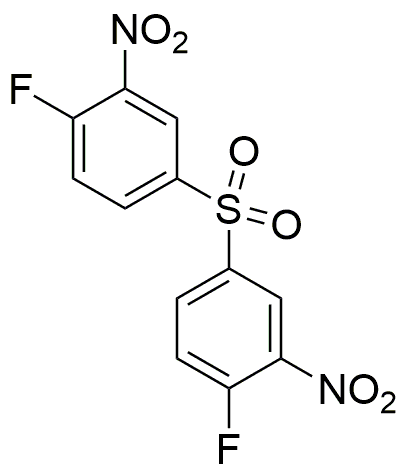Bis(4-fluoro-3-nitrophenyl) sulfone is widely utilized in research focused on:
- Pharmaceutical Development: This compound serves as a key intermediate in the synthesis of various pharmaceutical agents, particularly those targeting specific diseases due to its unique electronic properties.
- Material Science: It is used in the development of advanced materials, including polymers and coatings, that require enhanced thermal stability and chemical resistance.
- Agricultural Chemicals: The compound plays a role in the formulation of agrochemicals, contributing to the effectiveness of pesticides and herbicides by improving their stability and efficacy.
- Analytical Chemistry: It is employed as a reagent in analytical methods for detecting and quantifying other chemical substances, providing accurate results in complex mixtures.
- Environmental Monitoring: This chemical is utilized in studies assessing environmental pollutants, helping researchers track and analyze the presence of harmful substances in ecosystems.
General Information
Properties
Safety and Regulations
Applications
Bis(4-fluoro-3-nitrophenyl) sulfone is widely utilized in research focused on:
- Pharmaceutical Development: This compound serves as a key intermediate in the synthesis of various pharmaceutical agents, particularly those targeting specific diseases due to its unique electronic properties.
- Material Science: It is used in the development of advanced materials, including polymers and coatings, that require enhanced thermal stability and chemical resistance.
- Agricultural Chemicals: The compound plays a role in the formulation of agrochemicals, contributing to the effectiveness of pesticides and herbicides by improving their stability and efficacy.
- Analytical Chemistry: It is employed as a reagent in analytical methods for detecting and quantifying other chemical substances, providing accurate results in complex mixtures.
- Environmental Monitoring: This chemical is utilized in studies assessing environmental pollutants, helping researchers track and analyze the presence of harmful substances in ecosystems.
Documents
Safety Data Sheets (SDS)
The SDS provides comprehensive safety information on handling, storage, and disposal of the product.
Product Specification (PS)
The PS provides a comprehensive breakdown of the product’s properties, including chemical composition, physical state, purity, and storage requirements. It also details acceptable quality ranges and the product's intended applications.
Certificates of Analysis (COA)
Search for Certificates of Analysis (COA) by entering the products Lot Number. Lot and Batch Numbers can be found on a product’s label following the words ‘Lot’ or ‘Batch’.
*Catalog Number
*Lot Number
Certificates Of Origin (COO)
This COO confirms the country where the product was manufactured, and also details the materials and components used in it and whether it is derived from natural, synthetic, or other specific sources. This certificate may be required for customs, trade, and regulatory compliance.
*Catalog Number
*Lot Number
Safety Data Sheets (SDS)
The SDS provides comprehensive safety information on handling, storage, and disposal of the product.
DownloadProduct Specification (PS)
The PS provides a comprehensive breakdown of the product’s properties, including chemical composition, physical state, purity, and storage requirements. It also details acceptable quality ranges and the product's intended applications.
DownloadCertificates of Analysis (COA)
Search for Certificates of Analysis (COA) by entering the products Lot Number. Lot and Batch Numbers can be found on a product’s label following the words ‘Lot’ or ‘Batch’.
*Catalog Number
*Lot Number
Certificates Of Origin (COO)
This COO confirms the country where the product was manufactured, and also details the materials and components used in it and whether it is derived from natural, synthetic, or other specific sources. This certificate may be required for customs, trade, and regulatory compliance.


